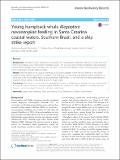Files in this item
Young humpback whale Megaptera novaeangliae feeding in Santa Catarina coastal waters, Southern Brazil, and a ship strike report
Item metadata
| dc.contributor.author | Bortolotto, Guilherme A. | |
| dc.contributor.author | Kolesnikovas, Cristiane Kiyomi Miyaji | |
| dc.contributor.author | Freire, Andrea Santarosa | |
| dc.contributor.author | Simões-Lopes, Paulo César | |
| dc.date.accessioned | 2019-10-10T16:30:04Z | |
| dc.date.available | 2019-10-10T16:30:04Z | |
| dc.date.issued | 2016-07-13 | |
| dc.identifier | 261541523 | |
| dc.identifier | 13a6bfbb-f87a-4245-84bb-a893ea0f297c | |
| dc.identifier | 84979966372 | |
| dc.identifier.citation | Bortolotto , G A , Kolesnikovas , C K M , Freire , A S & Simões-Lopes , P C 2016 , ' Young humpback whale Megaptera novaeangliae feeding in Santa Catarina coastal waters, Southern Brazil, and a ship strike report ' , Marine Biodiversity Records , vol. 9 , 29 , pp. 1-6 . https://doi.org/10.1186/s41200-016-0043-4 | en |
| dc.identifier.other | ORCID: /0000-0002-5343-6575/work/63046000 | |
| dc.identifier.uri | https://hdl.handle.net/10023/18641 | |
| dc.description.abstract | Background Humpback whales Megaptera novaeangliae are cosmopolitan and highly migratory animals that rarely feed in low latitude waters during their breeding seasons. The western South Atlantic humpback whale population breeds off the Brazilian coast, from Natal (4°S) to Cabo Frio (23°S) and migration to their feeding grounds is known to be undertaken through offshore waters. Results Here we report on an unusual stranding of a young humpback whale that was feeding in the coastal waters of Santa Catarina state (27°S), in October 2014. Evidence of a ship strike and that the animal had fed in no more than a few hours before death are also presented. Additionally, it is the first time that Peisos petrunkevitchi, a sergestid shrimp species, is described as prey for large whales. Conclusions Although more information is required before we can further discuss whether the area could provide an important source of food for young humpback whales, the present ship strike highlights a possibly important threat in case this ecological feature is confirmed in the future. | |
| dc.format.extent | 6 | |
| dc.format.extent | 3361421 | |
| dc.language.iso | eng | |
| dc.relation.ispartof | Marine Biodiversity Records | en |
| dc.subject | Large whale | en |
| dc.subject | Migration | en |
| dc.subject | Peisos petrunkevitchi | en |
| dc.subject | Prey | en |
| dc.subject | Distribution | en |
| dc.subject | Western South Atlantic | en |
| dc.subject | GC Oceanography | en |
| dc.subject | QH301 Biology | en |
| dc.subject | DAS | en |
| dc.subject.lcc | GC | en |
| dc.subject.lcc | QH301 | en |
| dc.title | Young humpback whale Megaptera novaeangliae feeding in Santa Catarina coastal waters, Southern Brazil, and a ship strike report | en |
| dc.type | Journal article | en |
| dc.contributor.institution | University of St Andrews. School of Biology | en |
| dc.contributor.institution | University of St Andrews. Sea Mammal Research Unit | en |
| dc.identifier.doi | 10.1186/s41200-016-0043-4 | |
| dc.description.status | Peer reviewed | en |
This item appears in the following Collection(s)
Items in the St Andrews Research Repository are protected by copyright, with all rights reserved, unless otherwise indicated.

